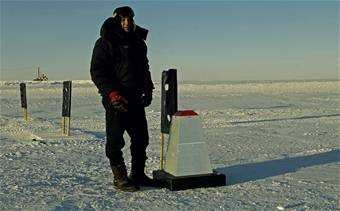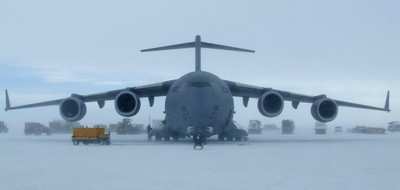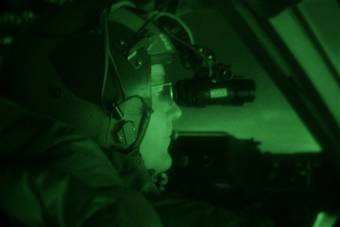First Known Reliance On Night Goggles, Reflective Cones
A C-17 Globemaster III crew from McChord Air Force Base, WA made
aviation history Thursday, performing the first known after-dark
landing on the Pegasus Ice Runway near McMurdo Station in
Antarctica, using night vision goggles.

The aircrew, consisting of active-duty Airmen from the 62nd
Airlift Wing and Reservists from the 446th Airlift Wing, was
testing the concept of using night vision technology in combination
with reflective cones and limited electrical lighting to land
safely on the Pegasus Ice Runway after dark. The crew is part of
Joint Task Force Support Forces Antarctica, headquartered at Hickam
AFB, Hawaii, and led by 13th Air Force. The joint task force is
currently conducting Operation DEEP FREEZE in support of the
National Science Foundation and US Antarctic Program.
There is no sunlight in Antarctica for several months of the
year, from around late March to mid-August. Until now, during this
time the runway was used only in emergency situations, and in such
cases 55-gallon drums of kerosene were lighted to illuminate the
runway -- a practice called "barrel burning" that doesn't provide a
particularly safe navigation aide, and isn't exactly
environmentally friendly.
The breakthrough makes it easier and safer for C-17 crews to get
into Antarctica any time of the year. Maj. Corey Simmons, an
evaluator pilot with McChord's 62nd Operations Support Squadron and
one of the pilots on the mission, said there are several reasons
the National Science Foundation may need strategic airlift during
winter months.

"One off the top of my head could be a contingency operation
where someone is sick or hurt down here during the winter-over
months when they have complete darkness for four and a half
months," Maj. Simmons said. "If they got sick enough or needed to
get out for whatever reason, we have the capability now to get them
out.
The use of high-tech night vision goggles and low-tech
reflective cones on the ground is a perfect complement to the
inherent strength of the C-17. The jet is built for night vision
operations; its Heads-Up-Display, or HUD, displays all the
aircraft's operating parameters directly in front of the pilot on a
piece of glass. This allows pilots to use night vision goggles to
survey the area while maintaining a close eye on the aircraft's
performance.
Flying strategic missions into the coldest, windiest, and most
inhospitable continent on the globe is a risky business. No one
knows this better than Lt. Col. Jim McGann, commander of the 304th
Expeditionary Airlift Squadron and the night vision goggles
concept's chief architect. He has by far the most experience in
flying strategic missions to Antarctica of any active pilot on
earth. With 12 years and more than 60 missions to The Ice under his
belt, he's just about seen it all.

"Previously we couldn't physically light the entire runway; it
wasn't possible," Colonel McGann said. "Now, with the inherent NVG
capability in the C-17, the increased technological advances of
night vision goggles and 64 high-intensity retro-reflective cones
placed on the runway edge, we can leverage the technologies and
say, 'let's see if we can get in there and access McMurdo at
night.' We found the cones to be very good at illuminating the
runway and providing critical situational awareness. When the
aircraft turns to final, the wingtip light reflects off the cones
to the NVG's and we can see the entire runway," he said.
And those reflections look familiar to pilots -- even those who
have never been to Antarctica.
"With the cones we can land just like we do all the time at
night at home," Colonel McGann said. "So now this becomes something
we do routinely, and if it's something we do routinely we're better
at it, we're more skilled at it--more proficient at it. I've never
landed on burn barrels, but I've landed on night vision goggles
before."
"The beauty of these cones is they light up like Christmas trees
even though they're not powered," Major Simmons said. "Even if you
looked under the NVGs with the naked eye you could see these things
from two, three miles out coming in to Pegasus. So the safety
factor that we were able to give to this type of mission by adding
something like this was exponential and probably the main safety
reason that allowed us to do it."
The successful test was the culmination of 18 months of
planning. The idea had to be solidified, and then the Air Force had
to approve use of the cones. But to the pilots on this mission, it
was well worth the effort.
"The National Science Foundation is going to be able to get in
year-round and do specific science experiments that they've never
been able to do before," Maj. Simmons said. "So the fact that 18
months of planning and tests and hard work finally put that C-17 on
the ground is definitely worth all the effort we put into it."
And this successful test precedes a bittersweet exit for Colonel
McGann; this will be his last season with the mission.

"It's time," Colonel McGann said. "I flew the first ever C-17
airdrop on the South Pole, now the first ever night vision goggle
landing on Antarctica. We've also developed the idea to land the
C-17 on South Pole with a wheeled aircraft and we've performed the
taxi tests to do just that. But like everything, new blood is
important. People seeing it with a new perspective and people with
outside ideas who haven't been here as long as I have, hopefully
those people will come into the program and bring it to the next
level."
Some of the young pilots Colonel McGann was talking about flew
on this mission. There were ten pilots on board; all got certified
to land on the ice in the dark using night vision goggles and the
cones as a reference.
"This is a revolution in Antarctic logistics because we can get
in here safely -- we've proven the concept--year 'round and that
capability will enable the amount of science to be increased 10
fold," Colonel McGann said.
"The opportunities for the NSF are unlimited, because now we can
get there and they know that, and now they can plan for it, and if
they can plan for it they can take advantage of the full
capabilities of the C-17," he said.
(Aero-News salutes Master Sgt. Chris Vadnais, Air Force News
Agency)
 Classic Aero-TV: The Switchblade Flying Car FLIES!
Classic Aero-TV: The Switchblade Flying Car FLIES! ANN FAQ: Q&A 101
ANN FAQ: Q&A 101 ANN's Daily Aero-Term (04.12.24): Discrete Code
ANN's Daily Aero-Term (04.12.24): Discrete Code ANN's Daily Aero-Term (04.13.24): Beyond Visual Line Of Sight (BVLOS)
ANN's Daily Aero-Term (04.13.24): Beyond Visual Line Of Sight (BVLOS) ANN's Daily Aero-Linx (04.13.24)
ANN's Daily Aero-Linx (04.13.24)






